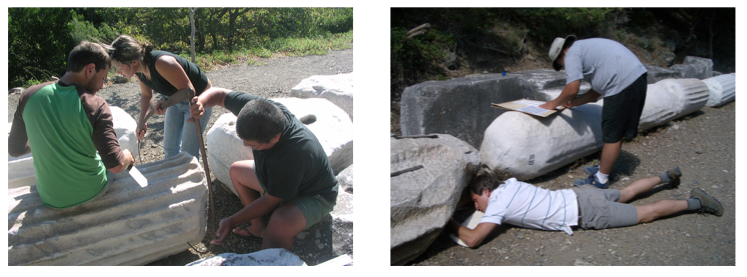Explanation of Data
Data Collection
We are in the process of obtaining a full data set of dimensions for each element on each surviving block from all the preserved structures in the Sanctuary, measured according to the same technique. The current sets of measurements for blocks in the Sanctuary (i.e., the “block books” and the published volumes) are inadequate for our analyses in three respects. First, they are incomplete. Second, the rough measurements made during the course of excavation, when architectural blocks are given an inventory number and moved to a block field, are helpful for identification, but they are not useful for a precision metric study such as the one we propose. Thirdly, the precisely measured blocks in the buildings that have been formally published (e.g., the Hieron (Lehmann, 1969)) usually include a single sample of a “regular block” for each course, as well as the unusual or irregular bocks upon which the reconstruction rests. Our study centers on the “regular blocks,” as they are the most likely to be designed on the basis of a quantum.
Block Measurements: To obtain meaningful results, consistency in the technique and instruments of measurement is critical. Our equipment includes steel 2, 5, and 30 m tape measures, steel and aluminum straight edges and angles, and steel calipers capable of measuring diameters of more than a meter. To measure a block, we first establish the extent of the preserved ancient surface on each side. On opposite sides of the block, steel straight edges are set with the thin edge over at least two points on the preserved ancient surface that allow for the straight edges to be aligned with each other and perpendicular to the dimension that will be measured. They must be set or project from the surface at the exact same position (relative to the surface being measured) on each side. The measurement is then taken parallel to the block and across the steel edges. Three people are needed to take the measurements of an ashlar (rectangular) block, two to hold the straight edges and one to take the measure and record it. The field research assistants are trained in the protocol prior to working in the field; the same supervisor has been training and working with the field crews each summer.
Measuring column drums is considerably more complicated, both for ancient and modern reasons. Greek columns have sophisticated refinements, including entasis (the practice of tapering more rapidly at the top than at the bottom, creating a curved rather than straight surface), and inclination (the column is designed to tilt inward), that make measuring each block a complex process. The task is further complicated by the current condition of many drums, in which the flutes are often badly battered and the edges near the top and bottom diameters destroyed. We therefore use two different kinds of equipment to measure each drum, steel straight edges and giant calipers. Using the steel straight edges we take measurements across at least four sets of flutes and arrises (Doric) or fillets (Ionic), if possible, to determine the lower and upper diameter of each drum. We measure the height at four points (across two diameters set at right angles) to determine if the drum has inclination. Using the calipers, we confirm the lower and upper diameter across the flute, and then measure the diameter at regular intervals of 0.25 m., to calculate the rate of diminution (see Figures 3a and 3b below).
Plan Measurements: In addition to measuring the blocks of each building, we also measure the plan in situ. We use two techniques: hand measurement with a 30 or 50 m steel tape, and measurement using the Leica TCR 805 Reflectorless Total Station and a Carlson Explorer II Data Collector. Each serves as a check upon the other.
Figs. 3(a) and 3(b). Sanctuary of the Great Gods, Samothrace. Measuring blocks and recording metric data in a database and scale drawings for the Milesian Banquet Hall. (3a) (left): Measurement of column drum using caliper. Student on left is prepared to hold straight edge. (3b) (right): Detailed measurements and recording.

